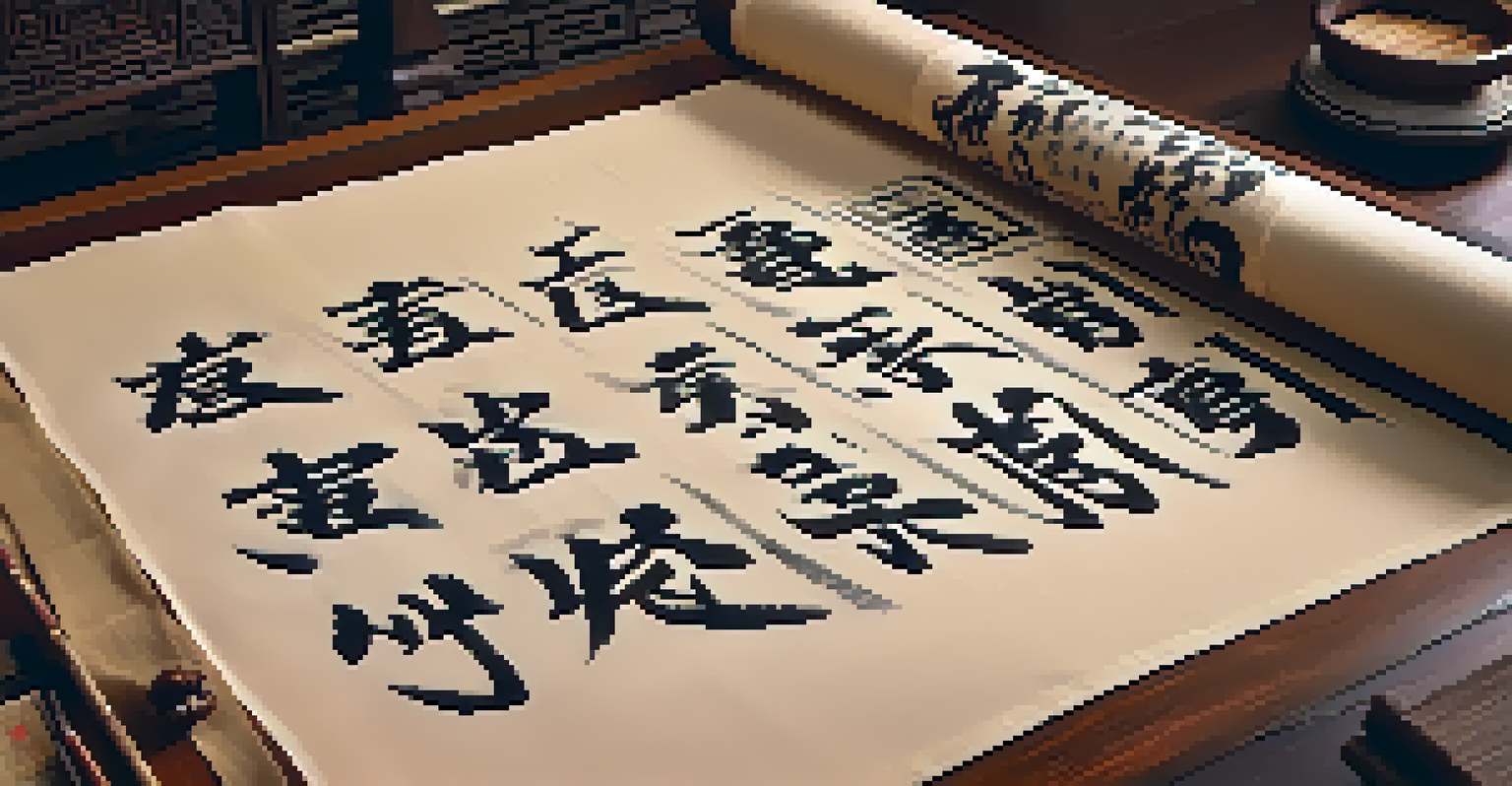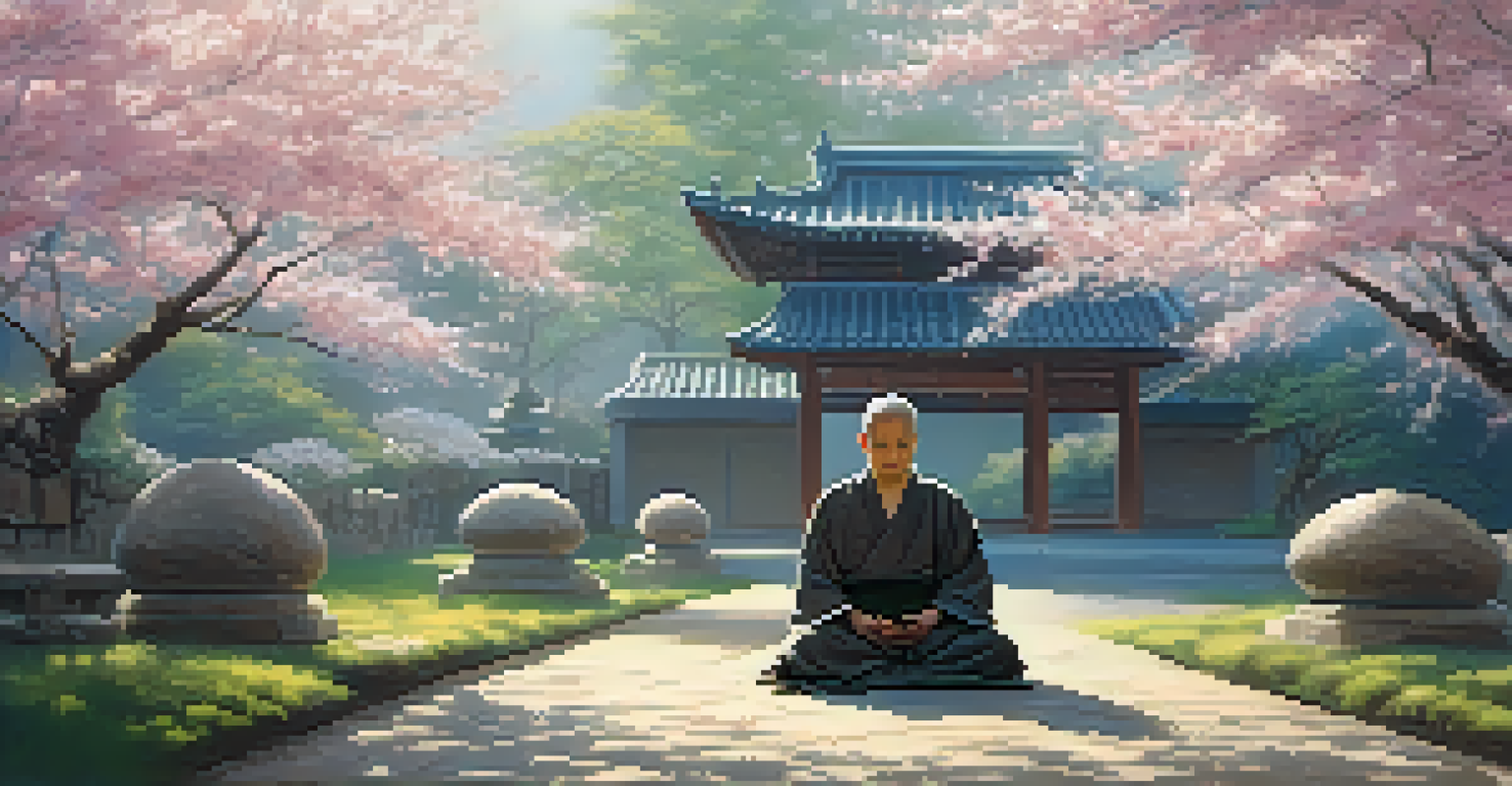The Influence of Ancient Chinese Texts on Martial Arts Today

Introduction to Ancient Chinese Texts and Martial Arts
Ancient Chinese texts, such as the Tao Te Ching and the Art of War, have profoundly influenced various aspects of Chinese culture, including martial arts. These writings are not just historical artifacts; they encapsulate philosophies and strategies that martial artists still apply today. By understanding these texts, practitioners can enhance their skills and deepen their appreciation for the art form.
The greatest victory is that which requires no battle.
Martial arts in China are not merely about physical prowess; they embody a rich tapestry of philosophy, ethics, and spirituality. The teachings found in ancient texts provide context for the principles behind techniques and movements. For instance, the concept of balance, often emphasized in these writings, is essential for both fighting and personal development.
This connection between ancient wisdom and contemporary practice is a testament to the enduring nature of these texts. As we dive deeper into this topic, we’ll explore specific texts and their direct influence on martial arts as we know them today.
The Tao Te Ching: Philosophy in Motion
The Tao Te Ching, attributed to Laozi, is a foundational text of Taoism that emphasizes harmony, balance, and the natural flow of life. These principles resonate deeply in martial arts, where understanding the flow of energy, or 'Qi', can significantly enhance a practitioner's effectiveness. Techniques are not just about brute strength but about yielding to and redirecting an opponent's energy.

For instance, the idea of 'wu wei', or effortless action, teaches martial artists to move in a way that feels natural and fluid rather than forced. This concept is evident in styles like Tai Chi, which focuses on slow, deliberate movements that embody the essence of the Taoist philosophy. Such practices promote not only physical agility but also mental clarity.
Ancient Texts Shape Martial Arts
Ancient Chinese writings like the Tao Te Ching and The Art of War provide foundational philosophies and strategies that enhance martial arts practice today.
Moreover, the Tao Te Ching’s teachings encourage practitioners to cultivate inner peace and self-awareness, integral components of martial arts training. By embracing these philosophies, martial artists can achieve a deeper connection with themselves and their art.
Sun Tzu's Art of War: Strategy and Tactics
The Art of War, written by Sun Tzu, is another seminal text that has significantly impacted martial arts, particularly in the realm of strategy. Its teachings emphasize the importance of preparation, adaptability, and understanding one's opponent—principles that are foundational to martial arts training. Whether in sparring or real combat, these strategies can determine success or failure.
Knowing others is intelligence; knowing yourself is true wisdom. Mastering others is strength; mastering yourself is true power.
One core lesson from the text is the idea of knowing both yourself and your enemy. This concept translates into martial arts as the necessity to develop self-awareness while also studying opponents’ techniques and tendencies. Such insights can lead to more effective defense and counterattack strategies during a match.
As martial artists incorporate these strategic lessons, they not only enhance their combat skills but also develop a mindset geared toward critical thinking and tactical planning. This multifaceted approach to training reflects the deep-rooted influence of Sun Tzu's work on martial arts practices today.
The Influence of Buddhism on Martial Arts
Buddhism's arrival in China brought profound philosophical changes that influenced martial arts, particularly in the development of Zen practices. The principles of mindfulness and meditation, which are central to Buddhism, encourage martial artists to cultivate a calm mind and focused spirit. This mental aspect is crucial for executing techniques effectively and maintaining composure under pressure.
Many martial arts schools integrate meditation practices into their training regimens, drawing directly from Buddhist teachings. For example, the practice of Zazen, or seated meditation, can help practitioners develop concentration and awareness, both essential for mastering complex movements and techniques. This blend of mental and physical training fosters a holistic approach to martial arts.
Buddhism Enriches Training Approaches
The principles of mindfulness and meditation from Buddhism have integrated into martial arts, fostering mental focus and ethical values among practitioners.
Furthermore, the concepts of compassion and respect for others, inherent in Buddhism, shape the ethical framework of martial arts. These values not only enhance the community aspect of training but also promote a sense of responsibility among practitioners.
Historical Texts and Their Role in Martial Arts Styles
Various historical texts have documented martial arts styles, techniques, and philosophies. Works such as the Bubishi and the Wujing Zongyao are treasure troves of knowledge that have guided practitioners for centuries. These texts often contain detailed explanations of techniques, forms, and the principles behind different martial arts styles, serving as critical references for students.
For instance, the Bubishi is considered a classic martial arts manual that combines practical techniques with philosophical insights. It offers guidance on not just physical confrontations, but also the mental and spiritual preparation needed for martial arts practice. Such resources continue to be influential in shaping modern martial arts curricula.
By studying these historical texts, martial artists gain a richer understanding of their art's lineage and evolution. This historical perspective fosters a deeper respect for the discipline, encouraging practitioners to honor the traditions while adapting them to contemporary practices.
Modern Interpretations of Ancient Philosophies
As martial arts have evolved, so too have interpretations of ancient philosophies. Many modern martial artists are revisiting these texts to find relevance in today's fast-paced world. The principles of adaptability and balance, for instance, resonate with contemporary challenges, helping practitioners navigate both physical and emotional obstacles.
Some martial arts schools have begun to integrate lessons from ancient texts into their training, creating a blend of traditional and modern approaches. This fusion not only enriches the training experience but also helps students cultivate a well-rounded perspective on martial arts, incorporating both physical skills and mental fortitude.
Modern Relevance of Ancient Wisdom
Current martial artists are revisiting ancient philosophies to find adaptability and balance, enriching their training and personal growth.
Moreover, the resurgence of interest in these ancient teachings reflects a growing desire for deeper meaning and purpose in martial arts practice. As practitioners explore these philosophies, they often find that the wisdom of the past can illuminate their path forward in the present.
Conclusion: The Lasting Legacy of Ancient Texts
The influence of ancient Chinese texts on martial arts is a testament to the enduring power of wisdom. These writings not only provide historical context but also offer timeless principles that continue to guide practitioners today. By integrating these teachings into their training, martial artists can cultivate a deeper connection with their art and themselves.
As we have seen, texts like the Tao Te Ching and The Art of War are more than just words; they are living philosophies that inform techniques, strategies, and mindsets. This legacy encourages a holistic approach, where physical training is complemented by mental and spiritual development.

Ultimately, as martial artists draw from the rich tapestry of ancient wisdom, they not only honor the traditions of their craft but also pave the way for future generations to thrive in their martial journeys.